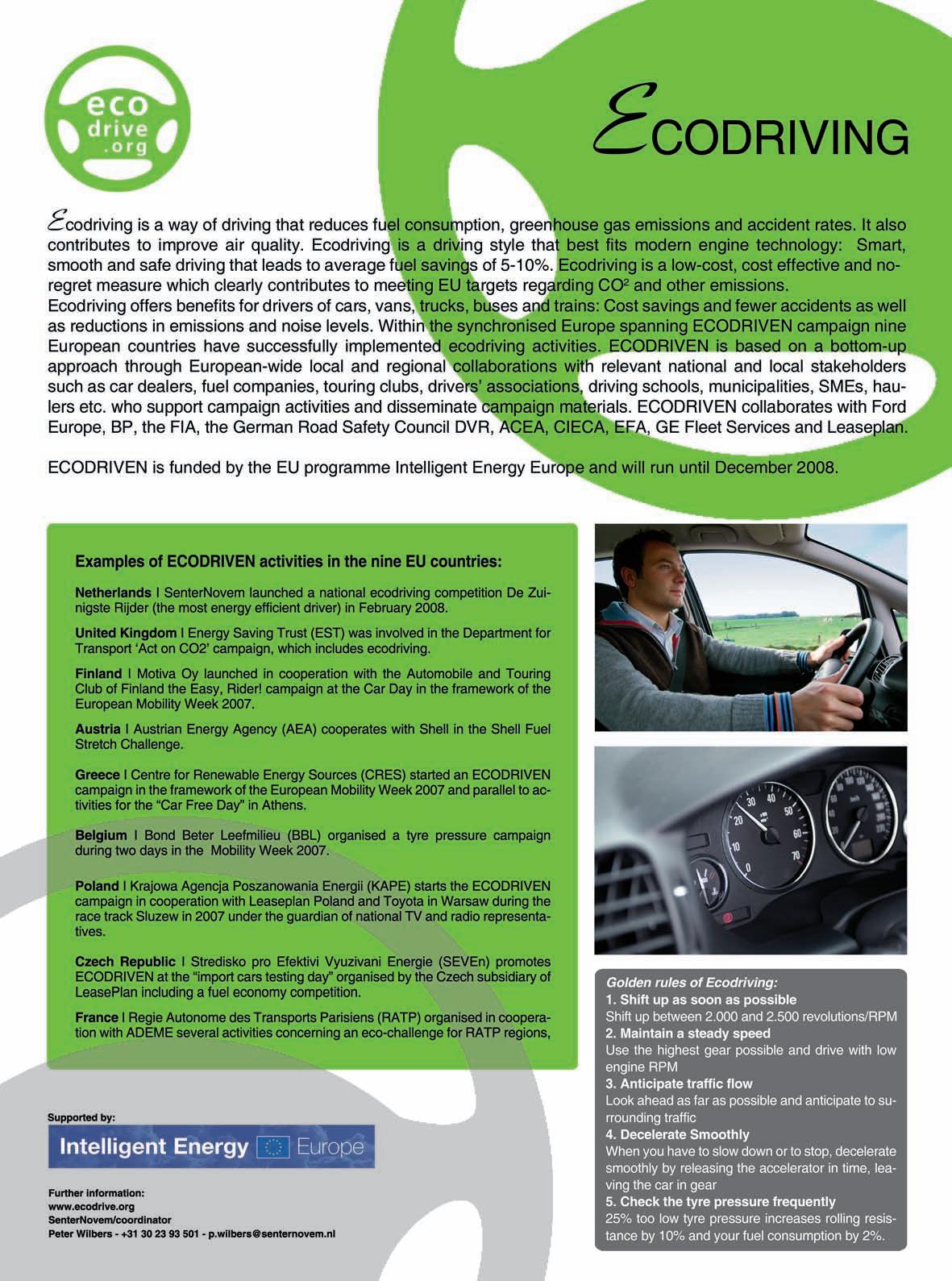
44 minute read
Dominique Strauss-Kahn
Europe’s growth conundrum
Mr Strauss-Kahn eyes the problem
© OECD
The gap in productivity and economic performance between the US and Europe has been a source of much debate in recent years, but many experts seem agreed on one point: that a lack of progress on reform in labour and product markets has not helped the European cause. This is a constant refrain of the OECD’s Going for Growth series (see page 25), and Structural Reform in Europe was also the theme of a one-day high-level conference jointly organised by the OECD and the IMF in Paris in March. Dominique Strauss-Kahn, managing director of the IMF, was a keynote speaker alongside Angel Gurría, secretarygeneral of the OECD. Other speakers included Joaquín Almunia from the European Commission, and Sweden’s employment minister, Sven Otto Littorin. The following is a short extract from Mr StraussKahn’s speech.
“This may seem like a strange time to be holding a conference on structural reform. We are in the middle of a financial crisis, which will have significant economic implications for many countries, so it seems that we have more urgent problems to address.
But actually, it’s a good time to talk about structural reform, because it has an important bearing on what Europe will be like when it emerges from the financial crisis, and because mobilising public support for reform is vital to the success of the European model.
I have said before that the European model is based on the desire to found a world of justice built on the irreducibility of human dignity. The model requires: that we take human rights seriously; that we focus on culture as a means of human development; that we achieve a balance between economic prosperity, social justice and the environment; and that we promote multilateralism. The key question is whether structural reforms—the kind of reforms that Angel Gurría has talked about—are consistent with this model. I believe that they are mostly consistent with the European model, and with European values; moreover they can provide important support for them, for two reasons. First, because all of the values that we hold will become easier to achieve in an environment of economic growth. Angel [Gurría] has explained very clearly the ways in which structural reforms can help Europe to compete successfully in world markets and to produce high growth. Second, structural reforms can help to create new opportunities for European citizens, which again supports European values. People—especially young people— don’t just want to be protected against failure; they also want the opportunity to be successful. […]
We see the benefits of these reforms clearly. But we must also recognise that people are hesitant about structural reform. Policymakers cannot dictate to people on this; they need to persuade people. […]
Finally, as we go forward, let us keep our eyes on the prize. The European model is the product of many years of passionate endeavour by the citizens of Europe. It is worth an equal expenditure of passion and effort to sustain it. The model is not static: European governments and institutions must learn from the world and adapt to changes in the world—as their citizens are already doing. But there is also much that Europe can give to the world if we hold fast to the principles of justice and human dignity, and if we approach our reforms with these values always in our minds.”
Mr Strauss-Kahn’s full speech can be read at www.oecd.org/speeches. For more information, contact the OECD Economics Department at reformineurope@oecd.org. See also pages 23-25.
Recent speeches by Angel Gurría
For a complete list of speeches and statements, including those in French and other languages, go to www.oecd.org/speeches
International investment 27 March 2008 Opening remarks at the Global Forum on International Investment (GFI-7) Paris, France Working in partnership for a harmonious globalisation 24 March 2008 Speech delivered at the China Development Forum Beijing, China Developing a healthcare system benefiting all March 23, 2008 Speech delivered at the China Development Forum 2008 Beijing, China Structural reform in Europe 17 March 2008 Keynote address at the OECD-IMF Conference on Structural Reform in Europe Paris, France A new OECD for new global challenges 6 March 2008 Speech to the Norwegian parliament Oslo, Norway Sustainable development and climate change 6 March 2008 Keynote speech at the seminar organised by the Norwegian government on “Sustainable development and climate change: International and national perspectives” Oslo, Norway Environmental outlook 5 March 2008 Speech at the worldwide launch of the OECD Environmental Outlook, hosted by Norway’s prime minister, Jens Stoltenberg Oslo, Norway Going for Growth 2008 4 March 2008 Remarks at the presentation of the fourth edition of Going for Growth at a press conference Paris, France The magic power of competition 21 February 2008 Opening remarks at the 7th meeting of the Global Forum on Competition Paris, France Immigrant populations in the 21st century 20 February 2008 Speech on the occasion of the launch of “A Profile of Immigrant Populations in the 21st Century” Paris, France Competition brings prosperity 20 February 2008 Speech on the occasion of the 100th meeting of the Competition Committee Paris, France Globalisation 11 February 2008 Public lecture on the OECD, globalisation and innovation: Responding to a changing global economy at the Tallinn University of Technology Tallinn, Estonia Netherlands outlook 31 January 2008 Remarks during a joint press conference held with the Dutch minister of economic affairs for the launch of the OECD Economic Survey of the Netherlands The Hague, Netherlands
Webwatch

© David Rooney
Wikigender.org: Did you know that over 40% of girls in Bangladesh are married before the age of 15? Or that 95% of Egyptian women had undergone some form of female genital cutting?
Women continue to suffer in far too many countries from serious social and economic discrimination, even repression. Though ending discrimination is essential for progress, clearly much more progress has to be made in forging gender rights at every level and in every country. In the developed world, women still encounter discrimination in education and at work. Indeed, the average median wages for men are still 15% higher than those for women in the OECD area. And today, nearly a century after the first International Women’s Day in 1911, just 23 out of 193 heads of state are women.
But even where reforms are introduced, how can we monitor real gains? How can we assess both advances and setbacks in gender equality, whether in politics or in business, or in normal everyday life? One approach is to encourage a wider exchange of experiences, to expose incidences, share insights and to create a momentum for change. This is what Wikigender (www.wikigender.org), a new website from the OECD Development Centre, aims to achieve. Launched on 7 March, the day before International Women’s Day, Wikigender enables users from the general public to view, add and edit material on gender equality. Once registered, users can access articles by using the search option, or browse by category of interest. Users will also be able to discuss and exchange opinions on information published on the website. The website also features a new article every week, an index and multiple links to information on gender equality.
The new site has already gathered a trove of information on women based on their religion, their country of origin and their social and economic situations. It has attracted worldwide media attention, with over 100,000 page clicks in its first few weeks of use and more than 120 users signed up to help manage the content. For more detail, contact Denis.Drechsler@oecd.org
Ask the economists: Environment: What price a cleaner planet? (March 2008) and Internet and development: Towards a Wider World Web (February 2008) were recent themes in this lively Q&A interative public debate series. See www.oecd.org/asktheeconomists
The OECD.Stat web browser, providing direct access to OECD’s databanks, has undergone a major revision. While still in beta, subscribers will find the new version has enhanced navigation, better graphics and improved performance. See www.sourceoecd.org/database/oecdstat
A new broadband portal has been launched, providing a range of broadband-related statistics gathered by the OECD. See www.oecd.org/sti/ict/broadband
Israel, a candidate for OECD membership, has launched a new website on its candidacy. See www.oecd.gov.il
How’s the competition?
It may be a truism among economists by now to state that more competition can improve a country’s economic performance by creating business opportunities, reducing costs of goods and services and boosting choice. But numerous laws and regulations still restrict competition in the marketplace. In its Competition Assessment Toolkit, the OECD has developed a new methodology for identifying unnecessary restraints and developing alternative, less restrictive policies that still achieve government objectives. One of the main elements of the toolkit is a competition checklist that asks a series of simple questions to screen for laws and regulations. For instance, proposals which grant exclusive rights for a supplier to provide goods or services, limit freedom of suppliers to advertise or market their goods or services, or create a self-regulatory or co-regulatory regime could harm competition.
The toolkit is designed for use by officials with no specialised training in economics or competition policy. It is available in several languages. Comments are welcome to help develop future versions. Contact: Sean.Ennis@oecd.org OECD (2007), Competition assessment toolkit, Paris. See www.oecd.org/daf/competition
New ambassadors
4 March - Norio Hattori is the new OECD ambassador for Japan. He succeeds Shinichi Kitajima.
4 March - Wolfgang Petritsch takes up his post as new ambassador for Austria succeeding Ulrich Stacher.
Calendar of forthcoming events
Please note that many of the OECD meetings mentioned are not open to the public or the media and are listed as a guide only. All meetings are in Paris unless otherwise stated. For a more comprehensive list, see the OECD website at www.oecd.org/media/upcoming, which is updated weekly.
MARCH - highlights
17 Structural Reform in Europe, conference organised by the Economics Department and the IMF.
27-28 Best Practices in Promoting
Investment for Development, forum on international investment organised by the Directorate for Financial and Enterprise Affairs.
31 Sovereign Wealth Funds in the Global Investment Landscape:
Building Trust, conference organised by the Directorate for Financial and Enterprise Affairs, with the IMF. London, UK.
APRIL
8 Publication of OECD Factbook 2008.
12-13 IMF/World Bank annual
meetings. Washington, DC, US.
16-17 Education Decision-Making and
Indicators, seminar organised by the Directorate for Education and the Chinese government. Beijing, China.
23 Risk Assessment of
Manufactured Nanomaterials, symposium organised by the OECD and the Japanese government. Tokyo, Japan. 23-25 Resource Efficiency, conference organised by the Environment Directorate and UNEP.
28-29 Environment ministers conference:
Environment Policy Committee meets at ministerial level.
MAY
7-8 Financial Education, conference organised by the Directorate for Financial and Enterprise Affairs and the US government. Washington, DC, US.
8 High-Growth SMEs and
Innovation, workshop organised by the Centre for Entrepreneurship, SMEs and Local Development. Kansas City, Missouri, US.
15-16 Learning in the 21st Century:
Research, Innovation and Policy, conference organised by the Directorate for Education.
11 African Economic Outlook 2008
launched, organised by the OECD Development Centre, at the African Development Bank annual meeting. Maputo, Mozambique.
20-21/5 Global Forum on Development, organised by the Development Assistance Committee (DAC), followed by the DAC high-level meeting.
28-30 International Transport Forum
2008, ministerial, Transport and Energy: the Challenge of Climate Change. Leipzig, Germany.
JUNE
3-4 OECD Forum 2008: Climate Change, Growth and Stability.
4 Economic Outlook No 83
published.
4-5 OECD Council meets at
ministerial level: Outreach, Reform and the Economics of Climate Change, chaired by France.
5-6 The Emerging Global University
Market, conference organised by the Education Directorate. Reykjavik, Iceland.
17-18 The Future of the Internet Economy, meeting at ministerial
level. Seoul, Korea.
JULY
7-9 G8 Summit. Hokkaido, Japan.
AUGUST
17-23 World Water Week. Stockholm, Sweden.

Problems of scale
Globalisation and Fisheries
Fisheries may be an ancient economic activity, but nowadays they are at the forefront of globalisation. First, there is the trade itself: a blue hake caught off the coast of New Zealand by a Japanese vessel may be processed in China before being flown to a market in London or Paris.
Fisheries form a highly sensitive sector too, with conservation pressures on fish stocks, heightened by the fact that more people around the world want to eat fish and many are prepared to pay dearly for it. The distribution of profit along the entire value chain raises questions as well. For “fin” fish such as tuna or tilapia, there is at least a US$10 dollar a kilo difference between what a consumer in a developed country pays, and what is paid to the developing country exporter. The consumer price of fillet is about 250% more than the export price. Yet value addition after the fish is exported is minimal.
All along the global supply chain, from fishers via processors to retailers, there are competing pressures. Take Darden Restaurants in the US, which sources seafood from over 30 countries. In Globalisation and Fisheries, Darden argues that to maintain per capita consumption
of 7.35 kg per annum by 2025 in the US, approximately 400,000 additional tons of fish and fish products (edible weight) will be required. That’s a 15-20% increase.

Fishers work hard to meet such demand, but the downside is that the competition leads to overfishing.
This affects the balance of ecosystems and aquatic life, damaging biodiversity. Reports of jellyfish infestations off
Mediterranean beaches are related to a decline in tuna stocks, for instance. Such shifts also affect climate change, both through reducing the ocean’s capacity to absorb carbon and via transport of fish to distant markets.
The accounts in this book present a wide range of experiences and points of view, and everyone agrees that sustainable, responsible management of fisheries is vital. But will that keep pressure on policymakers to deliver results, whether from investment, market reforms or better regulation? Consumers are not waiting: Tesco, the UK’s biggest retailer, has recently stated that it will put new labels on every one of the 70,000 products it sells so that shoppers can compare carbon costs in the same way they can compare calorie counts. Whether this type of initiative can lead to a healthier global fisheries market remains to be seen, though it may give locally caught hake competitive appeal.
ISBN 9789264037762
Beeting down the prices
Sugar Policy Reform in the European Union and in World Sugar Markets
Can cutting down on sugar subsidies lead to healthier trade competition and trimmer prices? The 2005 European Union market reforms aim to thin EU farmers’ sugar subsidies and cut out obsolete sugar mills. Sugar Policy Reform in the European Union and in World Sugar Markets maps out how this might work.

© M. Bur y/CEDUS
The historic volatility of sugar prices matches the spiky history of the commodity. Once reserved for the rich, and equal in value to musk, pearls and spices, today this kitchen staple can be vilified by health enthusiasts just as it is embraced by top chefs. And it has recently found new supporters and detractors because of its role in making biofuels. Sugar is certainly one of the most policy-distorted of all agricultural commodities, with high levels of protection of national sugar industries in OECD countries dating from the 1950s. So in 2005, when EU ministers agreed to radically reform the Common Market Organisation for sugar, there were mixed reactions from the industry, notably in Europe. The EU is currently the world’s third largest sugar producer, after Brazil and India, and ranks second in sugar consumption just after India. Three major producers–France, Germany and Poland–collectively account for more than half of the EU’s sugar output.
Sugar might not be the most expensive item in a shopping basket, but by maintaining high tariffs on imports, sugar subsidies have jacked the price in these countries up to three times the international market price. This ratchets up prices of other food produce as well. The EU reform will cut domestic support prices by 36%, from 631.9 per tonne today to 404.4 per tonne by 2010. It also calls for reduced quotas and a voluntary restructuring scheme that has already resulted in consolidation and closures of some of the EU’s surplus sugar producers and sugar beet growers.
ISBN 9789264040205
Forthcoming: OECD (2008), Agricultural Support, Farm Land Values and Sectoral Adjustment: The Implications for Policy Reform.
New OECD publications
Now available on www.sourceoecd.org
Twice a year, the OECD Economic Outlook analyses the major trends and examines the economic policies required to foster high and sustainable growth in member
countries. This covers the outlook to end-2009. In addition to the themes featured regularly, this issue contains a special chapter entitled “Corporate Saving and Investment: Recent Trends and Prospects”. Each edition of this Outlook provides a unique tool to keep abreast of world economic developments.
The Latin American Economic Outlook 2008 is designed to be an indispensable reference on Latin America’s economic trends, challenges and opportunities.
It is organised around four broad themes: 1) Policy Coherence: Improving Fiscal Policy; 2) Finance: Deepening Pension Reform; 3) Business: Investment and Telecommunications; and 4) Trade: Growing Trade with China and India. Contains innovative indicators and crossregional case studies.
PISA 2006: Science Competencies for Tomorrow’s World presents the results from the most recent PISA survey, which focused on science and also assessed mathematics and
reading. Volume 1: Analysis gives the most comprehensive international picture of science learning today, exploring not only how well students perform, but also their interests in science and their awareness of the opportunities that scientific competencies bring as well as the environment that schools offer for science learning. Volume 2: Data presents full data set underlying Volume 1.
GENERAL ECONOMICS
OECD Economic Outlook No. 82, December 2007
20-Jan-2008, 289 pages, € 85 $119 £6 ¥11800 SourceOECD: www.SourceOECD.org/04745574 Online Bookshop: www.oecd.org/bookshop?04745574
<<See left
OECD Economic Surveys: Chile 2007
31-Jan-2008, 178 pages, € 49 $66 £35 ¥6 800 SourceOECD: www.SourceOECD.org/9789264040069 Online Bookshop: www.oecd.org/bookshop?9789264040069
OECD Economic Surveys: Netherlands 2008
31-Jan-2008, 150 pages, € 52 $72 £37 ¥7 800 SourceOECD: www.sourceoecd.org/9789264040762 Online Bookshop: www.oecd.org/bookshop?9789264040762
AGRICULTURE
Agricultural Policies in OECD Countries
31-Oct-2007, 288 pages, € 65 $84 £46 ¥9 000 SourceOECD: www.SourceOECD.org/9789264027466 Online Bookshop: www.oecd.org/bookshop?9789264027466
DEVELOPMENT
Latin American Economic Outlook 2008
23-Nov-2007, 192 pages, € 50 $65 £36 ¥6 900 SourceOECD: www.SourceOECD.org/9789264038264 Online Bookshop: www.oecd.org/bookshop?9789264038264
<<See left
Policy Coherence for Development 2007: Migration and Developing Countries
23-Nov-2007, 152 pages, € 40 $52 £28 ¥5 500 SourceOECD: www.SourceOECD.org/9789264033115 Online Bookshop: www.oecd.org/bookshop?9789264033115
Development Aid at a Glance 2007
8-Nov-2007, 159 pages, € 24 $31 £17 ¥3 300 SourceOECD: www.SourceOECD.org/9789264022249 Online Bookshop: www.oecd.org/bookshop?9789264022249
Chinese Economic Performance in the Long Run, Second Edition
by Angus Maddison 18-Oct-2007, 200 pages, € 39 $50 £28 ¥5 400 SourceOECD: www.SourceOECD.org/9789264037625 Online Bookshop: www.oecd.org/bookshop?9789264037625
EDUCATION
PISA 2006: Science Competencies for Tomorrow’s World, Vol. 1: Analysis
14-Dec-2007, 390 pages, € 40 $52 £28 ¥5 500 SourceOECD: www.SourceOECD.org/9789264040007 Online Bookshop: www.oecd.org/bookshop?9789264040007
<<See left
No More Failures: Ten Steps to Equity in Education
30-Nov-2007, 155 pages, € 24 $29 £17 ¥3 300 SourceOECD: www.SourceOECD.org/9789264032590 Online Bookshop: www.oecd.org/bookshop?9789264032590
Higher Education Management and Policy: Vol. 19, No. 3
This issue features articles on revenue generation, academic capital, values and autonomy; liability of researchers in cases of scientific fraud; academic and professional standards in the UK, affirmative action at a Brazilian university; university governance in Sweden; and values, ethics and teacher education.
7-Dec-2007, 126 pages, 2008 Subscription: € 120 $154 £82 ¥16 800
SourceOECD: www.SourceOECD.org/16823451 Online Bookshop: www.oecd.org/bookshop?16823451
Basic Education in Turkey
27-Nov-2007, 166 pages, € 30 $40 £21 ¥4 100 SourceOECD: www.SourceOECD.org/9789264030091 Online Bookshop: www.oecd.org/bookshop?9789264030091
Quality and Equity of Schooling in Scotland
17-Dec-2007, 167 pages, € 30 $39 £21 ¥4 100 SourceOECD: www.SourceOECD.org/9789264040991 Online Bookshop: www.oecd.org/bookshop?9789264040991
EMPLOYMENT
Babies and Bosses - Reconciling Work and Family Life
A synthesis of findings for OECD countries 3-Dec-2007, 218 pages, € 29 $37 £20 ¥4 000 SourceOECD: www.SourceOECD.org/9789264032446 Online Bookshop: www.oecd.org/bookshop?9789264032446
See right>>
ENERGY
Oil Supply Security: Emergency Response of IEA Countries 2007
7-Dec-2007, 386 pages, € 100 $140 £72 ¥13 900 SourceOECD: www.SourceOECD.org/9789264040038 Online Bookshop: www.oecd.org/bookshop?9789264040038
Energy Policies of IEA Countries: Switzerland 2007
7-Dec-2007, 128 pages, € 75 $105 £54 ¥10 400 SourceOECD: www.SourceOECD.org/9789264030695 Online Bookshop: www.oecd.org/bookshop?9789264030695
FINANCE & INVESTMENT / INSURANCE & PENSIONS
Financial Market Trends: Vol. 2007, No. 2
This issue includes articles on structured products, hedge funds, institutional investors in Latin America, collective pension funds, the Indian financial system, and ultra-long government bonds. Starting in 2008, this content will be included in the OECD Journal available on subscription only from the Online Bookshop. 11-Dec-2007, 246 pages SourceOECD: www.SourceOECD.org/0378651X Online Bookshop: www.OECD.org/bookshop?0378651X
See right>>
OECD Investment Policy Reviews: Egypt
29-Oct-2007, 75 pages, € 30 $39 £21 ¥4 100 SourceOECD: www.SourceOECD.org/9789264034617 Online Bookshop: www.oecd.org/bookshop?9789264034617
Asian Insolvency Systems: Closing the Implementation Gap
7-Dec-2007, 284 pages, € 60 $78 £43 ¥8 300 SourceOECD: www.SourceOECD.org/9789264038325 Online Bookshop: www.oecd.org/bookshop?9789264038325
Enforcement of Corporate Governance in Asia: The Unfinished Agenda
14-Jan-2008, 124 pages, € 30 $39 £21 ¥4 100 SourceOECD: www.SourceOECD.org/9789264035508 Online Bookshop: www.oecd.org/bookshop?9789264035508
Protecting Pensions: Policy Analysis and Examples from OECD Countries
7-Nov-2007, 319 pages, € 50 $67 £36 ¥6 900 SourceOECD: www.SourceOECD.org/9789264028104 Online Bookshop: www.oecd.org/bookshop?9789264028104
GOVERNANCE
OECD Journal on Budgeting, Vol. 7, No. 2
This issue includes articles on budgeting in Turkey, structural balance policy in Chile, integrating current and development budgets, performance budgeting and accrual budgeting, and engaging the public in national budgeting. Starting in 2008, this content will be included in the OECD Journal available on subscription only from the Online Bookshop. 16-Nov-2007, 182 pages SourceOECD: www.SourceOECD.org/16087143 Online Bookshop: www.oecd.org/bookshop?16087143
Cutting Red Tape: Comparing Administrative Burdens across Countries
23-Oct-2007, 180 pages, € 50 $65 £36 ¥6 900 SourceOECD: www.SourceOECD.org/9789264008212 Online Bookshop: www.oecd.org/bookshop?9789264008212
See right>>
OECD Territorial Reviews: Yucatan, Mexico
28-Nov-2007, 226 pages, € 40 $56 £28 ¥5 500 SourceOECD: www.SourceOECD.org/9789264037021 Online Bookshop: www.oecd.org/bookshop?9789264037021
INDUSTRY AND SERVICES
Globalisation and Regional Economies
31-Oct-2007, 246 pages, € 70 $91 £50 ¥9 700 SourceOECD: www.SourceOECD.org/9789264037793 Online Bookshop: www.oecd.org/bookshop?9789264037793
NUCLEAR ENERGY
Radioactive Waste Management in Spain
23-Nov-2007, 145 pages, € 40 $52 £28 ¥5 500 SourceOECD: www.SourceOECD.org/9789264039414 Online Bookshop: www.oecd.org/bookshop?9789264039414
Transparency of Nuclear Regulatory Activities: Workshop Proceedings
29-Nov-2007, 318 pages, € 60 $84 £43 ¥8 300 SourceOECD: www.SourceOECD.org/9789264040953 Online Bookshop: www.oecd.org/bookshop?9789264040953
Getting familyfriendly policies right will help reduce poverty, promote child development, enhance equity between men and women and stem the fall in birth
rates, according to Babies and Bosses. This bookcompares the different approaches that the 30 OECD countries take to help parents balance their work and family commitments. The report analyses tax and benefit policies, parentalleave arrangements, childcare, out-ofschool-hours care, and workplace practices.
Financial Market Trends provides a six-monthly update of trends and prospects in the international and major domestic financial markets of the OECD area and
beyond. The current issue features articles on Current Financial Market Highlights, Structured Products, Hedge Funds, Corporate Governance in Latin America, Collective Pension Funds in China, Indian Financial System Reform, and Public Debt Management and the Evolving Market for (Ultra-) Long Government Bonds.
Cutting red tape to improve business conditions has become a priority in OECD
countries. This pilot study measures and compares administrative burdens in the transport sector across eleven member countries: Belgium, Canada, Denmark, France, Germany, Italy, the Netherlands, New Zealand, Norway, Sweden and Turkey. The aim of the exercise is twofold: to identify good practices and to develop and test a method for cross-country comparison.
Sign up for our free e-mail alerting service and for various e-newsletters, including our monthly What’s New at OECD at www.oecd.org/oecddirect
Did you know that OECD countries spend between 6 and 15% of GDP on health, but that spending more does not guarantee healthier
populations. This publication provides the latest comparable data and trends on different aspects of the performance of health systems in OECD countries. It provides striking evidence of large variations across countries in indicators of health status and health risks, as well as in the inputs and outputs of health systems.
Weather forecasting, air traffic control, global communications and broadcasting, disaster
management –these and many other key activities would be almost unthinkable today without satellite technology. The space industry itself is relatively small but its technological dynamism and strategic significance mean that it plays an ever more critical role in modern society. Paradoxically, it also figures among the sectors which are the least developed in terms of robust, internationally comparable statistics and data.
Drawing on an expanding array of intelligent web services and applications, a growing number of people are creating, distributing and exploiting user-created
content (UCC) and being part of the wider participative web. Participative Web and User-Created Content: Web 2.0, Wikis and Social Networking describes the rapid growth of UCC and its increasing role in worldwide communication, and draws out implications for policy.
Publications listed on these pages are available at subscribing institutions via our online library, SourceOECD, at the URLs indicated. If your institution is not a subscriber, ask your librarian to subscribe today! These publications are also available through the OECD Online Bookshop at www.oecd.org/bookshop
SOCIAL AFFAIRS, MIGRATION AND HEALTH
Health at a Glance 2007: OECD Indicators
22-Nov-2007, 198 pages, € 25 $35 £18 ¥3 400 SourceOECD: www.SourceOECD.org/9789264027329 Online Bookshop: www.oecd.org/bookshop?9789264027329
<<See left
Sickness, Disability and Work, Vol. 2: Australia, Luxembourg, Spain and the United Kingdom
18-Dec-2007, 180 pages, € 35 $49 £25 ¥4 800 SourceOECD: www.SourceOECD.org/9789264038158 Online Bookshop: www.oecd.org/bookshop?9789264038158
Modernising Social Policy for the New Life Course
17-Dec-2007, 226 pages, € 45 $63 £32 ¥6 200 SourceOECD: www.SourceOECD.org/9789264041264 Online Bookshop: www.oecd.org/bookshop?9789264041264
SCIENCE AND INFORMATION TECHNOLOGY
The Space Economy at a Glance
29-Oct-2007, 105 pages, € 24 $29 £17 ¥3 300 SourceOECD: www.SourceOECD.org/9789264031098 Online Bookshop: www.oecd.org/bookshop?9789264031098
<<See left
Participative Web and User-Created Content
23-Oct-2007, 128 pages, € 24 $29 £17 ¥3 300 SourceOECD: www.SourceOECD.org/9789264037465 Online Bookshop: www.oecd.org/bookshop?9789264037465
<<See left
OECD Science, Technology and Industry: Scoreboard 2007
26-Oct-2007, 232 pages, € 60 $78 £43 ¥8 300 SourceOECD: www.SourceOECD.org/9789264037885 Online Bookshop: www.oecd.org/bookshop?9789264037885
TAXATION
Tax Co-operation 2007: Towards a Level Playing Field
7-Nov-2007, 222 pages, € 60 $78 £43 ¥8 300 SourceOECD: www.SourceOECD.org/9789264039025 Online Bookshop: www.oecd.org/bookshop?9789264039025
URBAN, RURAL AND REGIONAL AFFAIRS
Investment Strategies and Financial Tools for Local Development
23-Nov-2007, 236 pages, € 35 $45 £25 ¥4 800 SourceOECD: www.SourceOECD.org/9789264039858 Online Bookshop: www.oecd.org/bookshop?9789264039858
The Social Economy: Building Inclusive Economies
23-Nov-2007, 253 pages, € 40 $52 £28 ¥5 500 SourceOECD: www.SourceOECD.org/9789264039872 Online Bookshop: www.oecd.org/bookshop?9789264039872
RECENTLY UPDATED DATABASES
Main Economic Indicators SourceOECD: www.SourceOECD.org/16081234
Monthly Statistics of International Trade SourceOECD: www.SourceOECD.org/16081226
National Accounts SourceOECD: www.SourceOECD.org/16081188
International Trade by Commodity Statistics SourceOECD: www.SourceOECD.org/16081218
OECD Economic Surveys: Australia, Denmark OECD Review of Agricultural Policies: Chile Economic Policy Reforms: Going for Growth 2008 OECD Environmental Outlook to 2030
OECD Journal on Development, Vol. 9, No. 1: Development Co-operation Report National Accounts of OECD Countries, Vol. 4: General Government Accounts, 1995-2006
A Profile of Immigrant Populations in the 21st Century Students with Disabilities, Learning Difficulties and Disadvantages 2007 Tourism in OECD Countries 2008
FORTHCOMING
LATEST OECD POLICY BRIEFS
Economic Surveys: Chile, Mexico, Switzerland OECD Territorial Reviews: Madrid, Spain Climate Change: Meeting the Challenge to 2050 Financing Local Development Biofuels for Transport: Policies and Possibilities Innovation and Growth Consumption Taxes: the Way of the Future?
Focus on environment
ANALYSIS
Business and the Environment: Policy Incentives and Corporate Responses
16-Apr-2007, 118 pages, € 24 $30 £17 ¥3 300 SourceOECD: www.SourceOECD.org/9789264026209 Online Bookshop: www.oecd.org/bookshop?9789264026209
Instrument Mixes for Environmental Policy 8-Jun-2007, 238 pages, € 50 $67 £36 ¥6 900 SourceOECD: www.SourceOECD.org/9789264017801 Online Bookshop: www.oecd.org/bookshop?9789264017801
Environment and Regional Trade Agreements 22-Jun-2007, 234 pages, € 40 $54 £28 ¥5 500 SourceOECD: www.SourceOECD.org/9789264006652 Online Bookshop: www.oecd.org/bookshop?9789264006652
Cutting Transport CO2 Emissions: What Progress?
24-Jan-2007, 266 pages, € 70 $94 £50 ¥9 700 SourceOECD: www.SourceOECD.org/9789282103821 Online Bookshop: www.oecd.org/bookshop?9789282103821
Improving Recycling Markets
6-Dec-2006, 190 pages, € 35 $47 £25 ¥4 800 SourceOECD: www.SourceOECD.org/9789264029576 Online Bookshop: www.oecd.org/bookshop?9789264029576
Decoupling the Environmental Impacts of Transport from Economic Growth
16-Nov-2006, 118 pages, € 35 $47 £25 ¥4 800 SourceOECD: www.SourceOECD.org/9789264027121 Online Bookshop: www.oecd.org/bookshop?9789264027121
RECENT COUNTRY REVIEWS
OECD Environmental Performance Reviews: Australia
17-Mar-2008, 226 pages, € 45 $63 £32 ¥6 200 SourceOECD: www.SourceOECD.org/9789264039605 Online Bookshop: www.oecd.org/bookshop?9789264039605
OECD Environmental Performance Reviews: China
23-Jul-2007, 340 pages, € 45 $60 £32 ¥6 200 SourceOECD: www.SourceOECD.org/9789264031159 Online Bookshop: www.oecd.org/bookshop?9789264031159
OECD Environmental Performance Reviews: Denmark
25-Jan-2008, 185 pages, € 45 $63 £32 ¥6 200 SourceOECD: www.SourceOECD.org/9789264038554 Online Bookshop: www.oecd.org/bookshop?9789264038554
STATISTICS
Environmental Performance of OECD Agriculture since 1990
Comprehensive data on the environmental performance of agriculture in OECD countries. 15-May-2008, 500 pages, €90 $126 £64 ¥12 500 SourceOECD: www.SourceOECD.org/9789264040922 Online Bookshop: www.oecd.org/bookshop?9789264040922
Environment at a Glance: OECD Environmental Indicators
This book includes key environmental indicators for OECD countries. 21-Apr-2006, 159 pages, € 35 $44 £24 ¥4 800 SourceOECD: www.SourceOECD.org/9789264012189 Online Bookshop: www.oecd.orb/bookshop?9789264012189
CO2 Emissions from Fuel Combustion, 2007 Edition
Provides data on CO2 emissions for over 140 countries by sector and by fuel. 22-Nov-2007, 579 pages, €150 $195 £108 ¥20 800 SourceOECD: www.SourceOECD.org/9789264027718 Online Bookshop: www.oecd.org/bookshop?9789264027718
POLICY BRIEFS
Climate Change: Meeting the Challenge to 2050 Biofuels for Transport: Policies and Possibilities Making Environmental Spending Count Climate Change Policies The Political Economy of Environmentally Related Taxes Improving Recycling Markets The Social Dimension of Environmental Policy Putting Climate Change Adaptation in the Development Mainstream Keeping Water Safe to Drink Improving Water Management: Recent OECD Experience Advancing Sustainable Development
HIGHLIGHTS
OECD Environmental Outlook to 2030
The OECD Environmental Outlook to 2030 provides analyses of economic and environmental trends to 2030, and simulations of policy actions to address the key challenges. Without new policies, we risk irreversibly damaging the environment and the natural resource base needed to support economic growth and well-being. The Outlook shows that tackling the key environmental problems we face today is both achievable and affordable. It highlights a mix of policies that can address these challenges in a cost-effective way. 25-Feb-2008, 461 pages, €90 $117 £64 ¥12 500 SourceOECD: www.SourceOECD.org/9789264040489 Online Bookshop: www.oecd.org/bookshop?9789264040489
Climate Change in the European Alps
The first systematic cross-country analysis of snow-reliability of Alpine ski areas under climate change for five countries in the region: France, Switzerland, Austria, Italy and Germany. 22-Jan-2007, 130 pages, €24 $32 £17 ¥3 300 SourceOECD: www.SourceOECD.org/9789264031685 Online Bookshop: www.oecd.org/bookshop?9789264031685
Economic Valuation of Environmental Health Risks to Children
3-Feb-2006, 314 pages, €57 $71 £39 ¥7 800 SourceOECD: www.SourceOECD.org/9789264013971 Online Bookshop: www.oecd.org/bookshop?9789264013971
Bridge Over Troubled Waters: Linking Climate Change and Development
17-Nov-2005, 157 pages, €26 $33 £18 ¥3 500 SourceOECD: www.SourceOECD.org/9789264012752 Online Bookshop: www.oecd.org/bookshop?9789264012752
Attitudes and abilities
Students with Disabilities, Learning Difficulties and Disadvantages: Policies, Statistics and Indicators
“Attitudes are the real disability”, says Henry Holden, a well-known comedian and advocate for the disabled. Education is clearly important in this respect, but ironically, schools themselves have much to do in how they deal with disabled students. Whether teenagers are confined to a wheelchair or are struggling with epilepsy, dyslexia or depression, getting an education can be a tough test indeed.
For the past few decades, schools have taken on increasing responsibility for educating youth with disabilities and mainstreaming them into regular classrooms. Students with Disabilities, Learning Difficulties and Disadvantages, the fourth report in an ongoing OECD series on disabilities and education, takes a practical look at numbers, measuring how a sample of 17 countries provide for students with special needs.
The countries surveyed all have, or are currently preparing, laws that ensure full access to education for all students, although with varying degrees of focus. While many schools have introduced services like remedial instruction, special classrooms and on-site therapists, there are still gaps. Some countries classify special needs as those relating only to students with medical disabilities like blindness or autism, but not those with emotional or learning disorders, or gifted students.
This report by the OECD Centre for Educational Research and Innovation (CERI) tallies the number of special schools, special classes and how many students get additional resources per class, from pre-primary through to upper-secondary levels. It identifies legal and financial frameworks that encourage inclusion and equity, discusses why more male students seem to get educational resources for disabilities, and takes a look at the participation of students with disabilities in PISA, the OECD Programme for International Student Assessment.
By comparing different approaches in a purely objective way, this report helps policymakers and school districts learn how to continue changing attitudes and improve the lives of disabled people too.
ISBN 9789264027626

© REUTERS/Ognen T eofilovski
ORDER FORM
Subscribe to the OECD OBSERVER Special two-year rates available only at www.oecdobserver.org/subscribe.html ❏
Yes, please enter my subscription for six issues plus free OECD in Figures annual supplement, worth 15.
64 US$82 £43 ¥8 900 Subscription will commence with the next available issue. Subscribers will be provided with the English language edition unless otherwise indicated.
❏ English language edition ISSN 0029-7054 ❏ French language edition ISSN 0304-3398
You can order your BOOKS either online at www.oecdbookshop.org or by mailing your choices from the New publications titles in this section to one of the addresses below.
Where do we deliver?
Name . . . . . . . . . . . . . . . . . . . . . . . . . . . . . . . . . . . . . . . . . . . . . . . . . . . . . . . . . . . . . . . . . . . . . . . . . . . . . . Organisation . . . . . . . . . . . . . . . . . . . . . . . Position held. . . . . . . . . . . . . . . . . . . . . . . . . . . . . . . . . . . . . . . Address. . . . . . . . . . . . . . . . . . . . . . . . . . . . . . . . . . . . . . . . . . . . . . . . . . . . . . . . . . . . . . . . . . . . . . . . . . . . .
. . . . . . . . . . . . . . . . . . . . . . . . . . . . . . . . . . . . . . . . . . . . . . . . . . . . . . . . . . . . . . . . . . . . . . . . . . . . . . . . . . . . Postcode . . . . . . . . . . . . . . . . . . . . . . . . . . . . . . . . . . City . . . . . . . . . . . . . . . . . . . . . . . . . . . . . . . . . . . . . . .
Payment details
❏ Cheque/money order enclosed (payable to OECD) ❏ Please charge my VISA/MasterCard/American Express TOTAL amount due. . . . . . . . . . . . . . . . . . . . . . . . . . . . Card number. . . . . . . . . . . . . . . . . . . Card Expiry Date. . . . . . . . . . . . . . . . . . . . . . . . . . . . . . . . . . . . . . . Country. . . . . . . . . . . . . . . . . . . . . . . . . . . . . . . . . . . . . . Telephone. . . . . . . . . . . . . . . . . . . . . . . . . . . . . . . . . . . . Fax. . . . . . . . . . . . . . . . . . . . . . . . . . . . . . . . . . . . . . . . . E-mail. . . . . . . . . . . . . . . . . . . . . . . . . . . . . . . . . . . . . . .
Signature. . . . . . . . . . . . . . . . . . . . . . . . . . . . . . . . . . . . . Date . . . . . . . . . . . . . . . . . . . . . . . . . . . . . . . . . . . . . . . .
Where to send your mail or fax order For customers in the US
Turpin Distribution The Bleachery 143 West Street, New Milford Connecticut 06776 USA Tel: (1) 800 456 6323 Fax: (1) 860 530 0039 Email: oecdna@turpin-distribution.com
For customers in the rest of the world
Turpin Distribution Services Ltd. Stratton Business Park Pegasus Drive, Biggleswade Bedfordshire SG18 8QB, UK Tel: (44) 1767 604 960 Fax: (44) 1767 604 640 E-mail: oecdrow@extenza-turpin.com
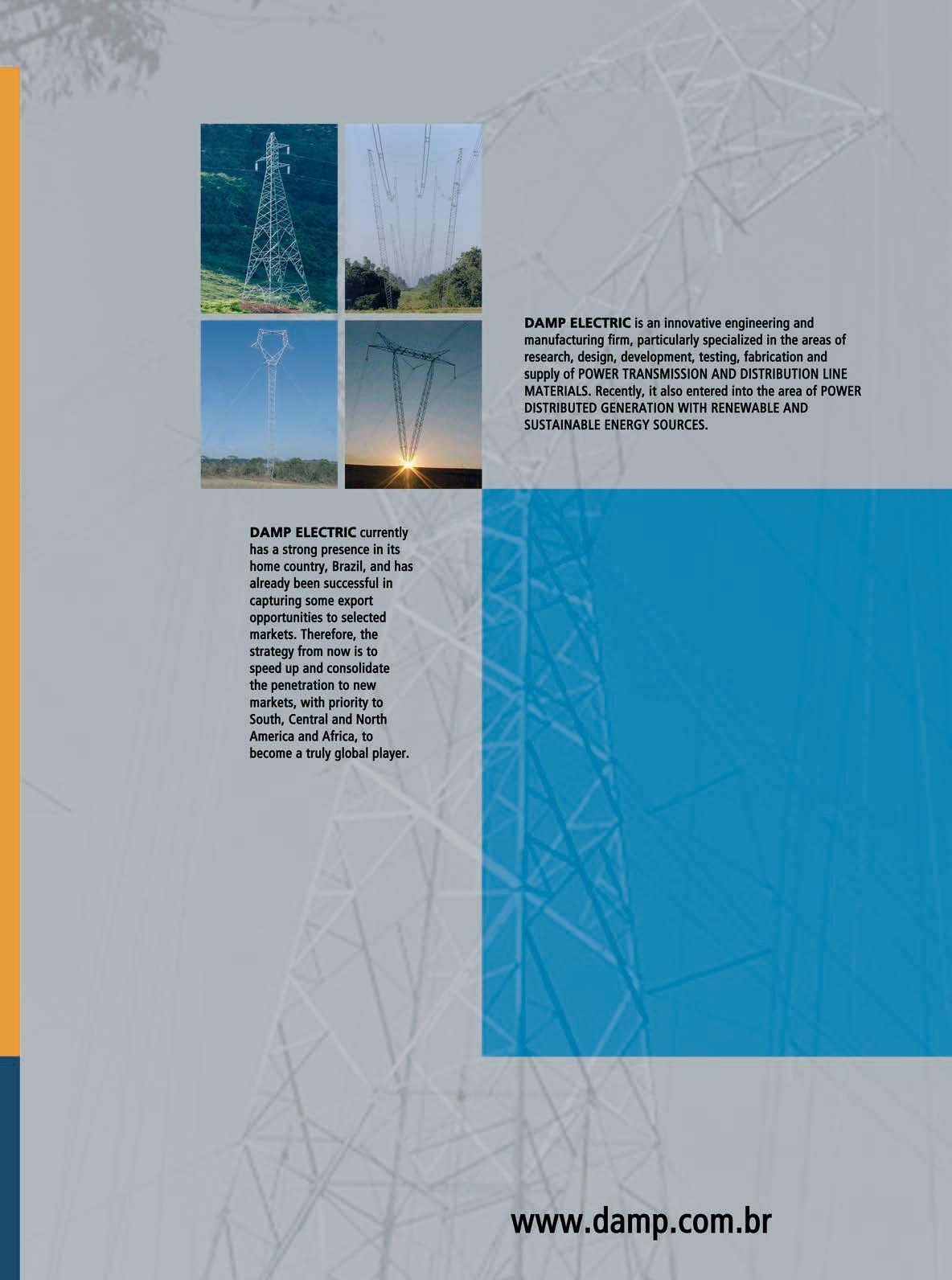

US energy
The United States is dependent on fossil fuels for almost all its energy supply. Coal dominates electricity generation, accounting for half of its power production, with nuclear and natural gas around one-fifth each. Natural gas overtook nuclear to become the second biggest source of power in 2006, reports a recent publication, Energy Policies of IEA Countries: United States, and renewable energy sources, including hydro, produced 9.5% of electricity.
Electricity demand in the US increased by 41% between 1990 and 2005, and is expected to continue growing, albeit at a slower rate, says the IEA. Gas-fired power plants represent about half of new capacity currently under construction, and most capacity additions over the period to 2010 and even 2015 are also expected to be gasbased. Beyond 2015, coal-fired plants are expected to play a more important role, and will eventually make up more than half of newly added capacity in 2006-2030, leaving gas with 36% of new capacity up to 2030. Renewable energy is expected to provide around 6% of new capacity, says the study, thanks in part to the influence of renewable energy standards introduced in some states. New energy sources such as geothermal, biomass/waste, and solar capacity increased slightly from 2001 to 2005, while wind is the dominant new renewable energy source. New nuclear capacity is expected to provide around 4% of electricity. The report believes that a nuclear revival in the US is now likely, although the first new plants will not enter service until 2015 at the earliest, and then only in small numbers.
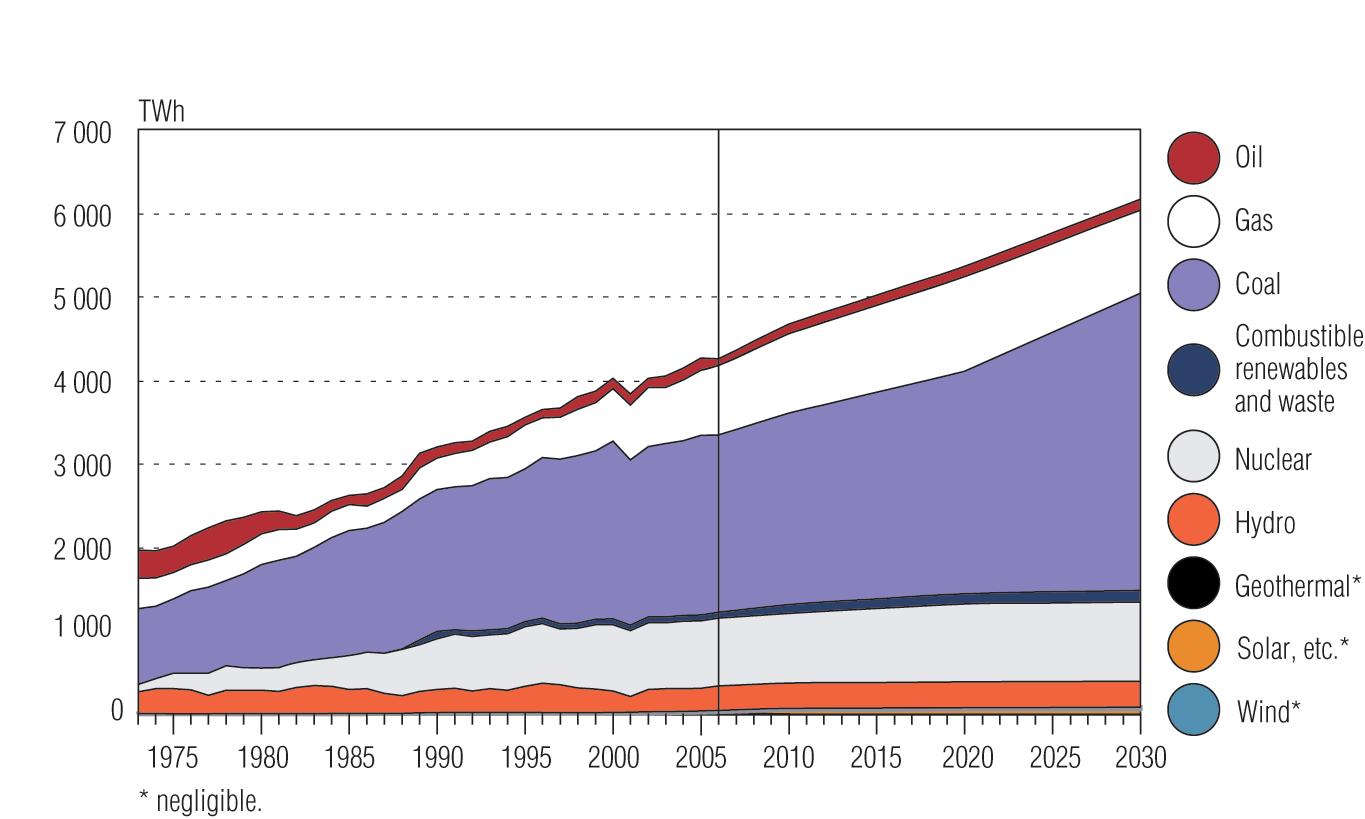
Environmental aid
Although the environment is high on the international policy agenda, development aid for the environment has declined in relation to total aid since 1996. This trend comes despite an increase in overall aid funding: from 2004 to 2005, total official development assistance (ODA) rose 32% to a record high of US$107.1 billion, though eased back somewhat in 2006 (see page 4). By 2005, environmentally-related aid was about $12 billion, up on its level of $10 billion in 1997. However, its share of total ODA nearly halved over the same period, from 19.6% to 10.2%. It remained stable at about 10% in 2002-2005.
Changes in the overall structure of aid explain some of the declining share. For instance, funds are often channelled through general budget support, making it harder to ensure aid goes towards the environment. Also, “core” environmental aid, covering the likes of conservation, waste management and renewable energy, fell partly because bilateral donors–which provided over 80% of this aid–shifted towards water-related assistance. Aid for projects other than the environment have seen reductions too, as more ODA has been allocated for debt relief, emergencies and other similar non-sector-specific aid.
For water the picture is mixed. Aid for the water sector will likely remain above 40% of total environmental aid, using broad definitions that take account of issues such as access in the Millennium Development Goals and resource management. But a narrower definition shows sector-allocable ODA to water supply and sanitation declining from about 11% of total sector-allocable ODA in 1997 to about 8% in 2006.
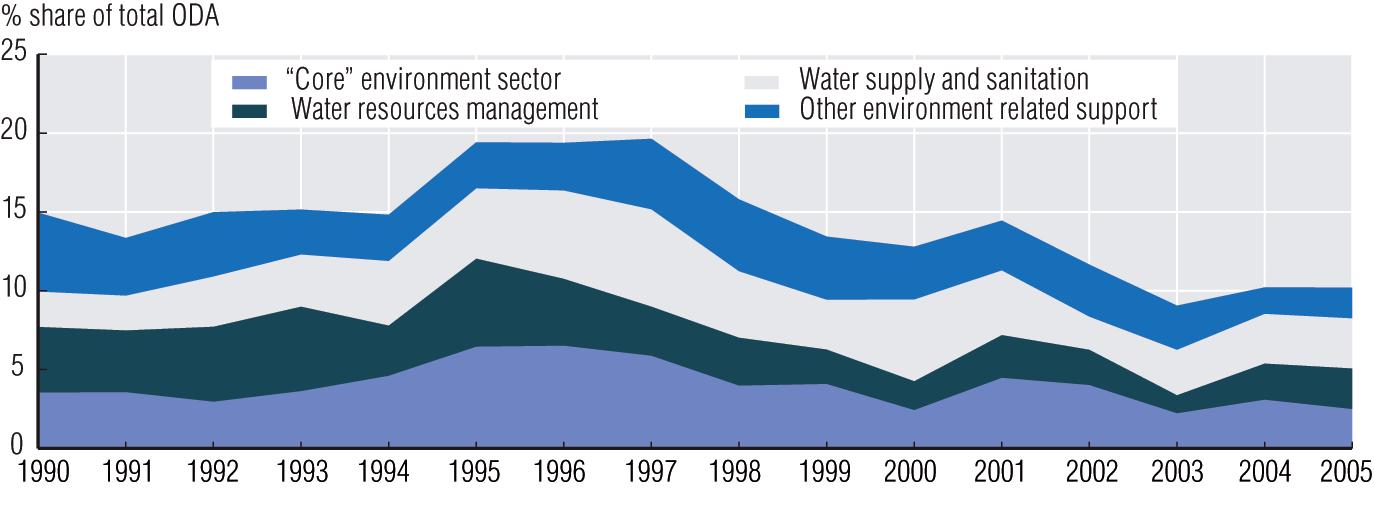
Fossil future?
Electricity generation by source, 1975-2030
Source: IEA (2008), Energy Policies of IEA Countries: United States
Energy Policies of IEA Countries: United States is available at www.oecdbookshop.org, ISBN 9789264030732.
Declining trend
Environment-related aid as % of total ODA, 1990-2005
Source: OECD (2008), Environmental Outlook to 2030
Note: Data refer to bilateral and multilateral ODA. 12 http://dx.doi.org/10.1787/262477124883
See more OECD development statistics on the Creditor Reporting System (CRS) database: www.oecd.org/dac/stats/idsonline
Australia
Austria
Belgium
Canada
Gross domestic product Leading indicator Consumer price index Gross domestic product Leading indicator Consumer price index Gross domestic product Leading indicator Consumer price index Gross domestic product Leading indicator Consumer price index Czech Republic Gross domestic product Leading indicator Consumer price index
Denmark
Gross domestic product Leading indicator Consumer price index
Finland
Gross domestic product Leading indicator Consumer price index
France
Gross domestic product Leading indicator Consumer price index
Germany
Gross domestic product Leading indicator Consumer price index
Greece
Gross domestic product Leading indicator Consumer price index
Hungary
Gross domestic product Leading indicator Consumer price index
Iceland
Gross domestic product
Ireland
Japan
Korea
Luxembourg
Mexico
Netherlands
New Zealand
Leading indicator Consumer price index Gross domestic product Leading indicator Consumer price index Gross domestic product Leading indicator Consumer price index Gross domestic product Leading indicator Consumer price index Gross domestic product Leading indicator Consumer price index Gross domestic product Leading indicator Consumer price index Gross domestic product Leading indicator Consumer price index Gross domestic product Leading indicator Consumer price index Gross domestic product Leading indicator Consumer price index
% change from:
previous period
previous year
Q4 07 0.6 3.9 Dec.07 -0.6 -0.5 Q4 07 0.9 3.0 Q4 07 0.7 3.3 Jan.08 0.0 -2.7 Jan.08 -0.3 3.3 Q4 07 0.5 2.4 Jan. 08 0.0 -1.0 Feb.08 0.7 3.6 Q4 07 0.2 2.9 Jan.08 -0.3 -2.4 Jan.08 -0.2 2.2 Q3 07 1.4 6.1 Jan.08 -0.7 2.1 Jan.08 3.0 7.6 Q4 07 0.4 2.0 Jan.08 -0.6 -3.4 Jan.08 0.3 2.9 Q4 07 0.9 3.8 Jan.08 -0.3 -2.3 Jan.08 1.0 3.8 Q4 07 0.3 2.1 Jan.08 -0.4 -1.4 Jan.08 -0.1 2.8 Q4 07 0.3 1.8 Jan.08 -0.1 -2.6 Jan.08 -0.4 2.8 Q4 07 0.7 3.6 Jan.08 -0.3 -3.1 Jan. 08 -0.3 3.9 Q4 07 0.1 0.5 Jan.08 -0.3 -1.5 Jan. 08 0.9 7.1 Q3 07 1.0 4.1
.. .. Feb. 08 1.4 6.9 Q3 07 1.4 3.9 Jan. 08 -1.1 -10.8 Jan.08 -0.5 4.3 Q3 07 0.4 1.9 Jan.08 0.4 -3.5 Feb.08 0.2 2.9 Q4 07 0.9 1.8 Jan.08 0.7 -4.4 Jan.08 -0.2 0.7 Q4 07 1.5 5.7 Jan.08 3.4 1.6 Feb. 08 0.4 3.6 Q3 07 0.7 5.6 Jan.08 -0.2 -3.7 Jan.08 -0.6 3.3 Q4 07 0.7 3.8 Jan. 08 0.8 0.8 Jan.08 0.5 3.7 Q4 07 1.2 4.3 Jan.08 0.1 -0.2 Jan.08 0.3 2.0 Q3 07 0.3 3.4 Dec. 07 -0.2 -3.4 Q4 07 1.2 3.2 Current balance Unemployment rate Interest rate Current balance Unemployment rate Interest rate Current balance Unemployment rate Interest rate Current balance Unemployment rate Interest rate Current balance Unemployment rate Interest rate Current balance Unemployment rate Interest rate Current balance Unemployment rate Interest rate Current balance Unemployment rate Interest rate Current balance Unemployment rate Interest rate Current balance Unemployment rate Interest rate Current balance Unemployment rate Interest rate Current balance Unemployment rate Interest rate Current balance Unemployment rate Interest rate Current balance Unemployment rate Interest rate Current balance Unemployment rate Interest rate Current balance Unemployment rate Interest rate Current balance Unemployment rate Interest rate Current balance Unemployment rate Interest rate Current balance Unemployment rate Interest rate Current balance Unemployment rate Interest rate
level:
current period
same period last year
Q4 07 -17.19 -11.60 Jan.08 4.10 4.50 Jan.08 7.18 6.43 Q3 07 0.95 1.83 Jan.08 4.20 4.50 * * Q3 07 3.01 3.28 Jan.08 7.00 7.90 * * Q4 07 -0.52 4.06 Jan.08 5.80 6.20 Feb.08 3.88 4.35 Q3 07 -1.81 -1.35 Jan.08 4.70 5.90 Feb.08 3.94 2.59 Q3 07 0.99 2.03 Dec. 07 3.10 3.70 Feb. 08 4.37 3.94 Dec.07 -0.61 0.13 Jan.08 6.40 7.10 * * Dec. 07 -3.95 -2.68 Jan. 08 7.80 8.70 * * Q4 07 66.75 50.91 Jan. 08 7.60 8.80 * * Dec.07 -6.05 -2.62 Sept.07 8.20 8.70 * * Q3 07 -2.07 -1.79 Jan.08 7.20 7.3 Feb.08 7.73 8.03 Q4 07 -1.29 -1.13 Jan. 08 0.80 1.10 Jan.08 15.05 16.87 Q3 07 -2.98 -2.27 Jan.08 4.70 4.30 * * Sept. 07 -5.84 -7.00 Sept.07 6.00 6.50 * * Dec. 07 16.49 16.27 Jan.08 3.80 4.00 Jan. 08 0.75 0.49 Jan. 08 -2.03 0.05 Jan.08 3.00 3.3 Feb. 08 5.28 4.95 Q3 07 1.35 1.24 Jan. 08 4.60 4.90 * * Q3 07 -1.65 -0.96 Dec. 07 3.80 3.90 Feb.08 7.51 7.19 Q3 07 12.65 13.10 Jan. 08 2.90 3.50 * * Q3 07 -2.69 -1.97 Q4 07 3.40 3.80 Feb.08 8.82 7.75
Norway
Poland
Gross domestic product Leading indicator Consumer price index Gross domestic product
Portugal
Leading indicator Consumer price index Gross domestic product Leading indicator Consumer price index Slovak Republic Gross domestic product Leading indicator Consumer price index
Spain
Sweden
Gross domestic product Leading indicator Consumer price index Gross domestic product
Switzerland
Turkey
Leading indicator Consumer price index Gross domestic product Leading indicator Consumer price index Gross domestic product Leading indicator Consumer price index United Kingdom Gross domestic product Leading indicator Consumer price index
United States
Gross domestic product
Euro area
Leading indicator Consumer price index Gross domestic product Leading indicator Consumer price index
% change from:
previous period
previous year
Q4 07 1.3 4.6 Jan.08 -1.6 0.5 Jan.08 -0.4 3.7 Q4 07 2.0 6.7 Jan.08 -0.5 -8.8 Dec.07 0.3 3.9 Q4 07 0.7 2.0 Jan.08 -0.6 -0.9 Jan.08 -0.1 2.9 Q4 07 3.1 11.7 Jan.08 -0.5 2.5 Jan. 08 1.3 3.8 Q4 07 0.8 3.5 Jan.08 -0.3 -1.9 Jan.08 -0.6 4.3 Q4 07 0.8 2.6 Jan. 08 -0.3 -3.1 Jan.08 -0.8 3.2 Q4 07 1.0 3.6 Jan.08 0.0 -5.5 Feb. 08 0.1 2.4 Q3 07 -1.2 1.8 Jan.08 2.6 -0.4 Jan.08 0.8 8.2 Q4 07 0.6 2.9 Jan.08 -0.4 -1.0 Jan.08 -0.7 2.2 Q4 07 0.2 2.5 Jan.08 -0.9 -2.6 Jan.08 0.5 4.3 Q4 07 0.4 2.2 Jan.08 -0.1 -2.4 Jan.08 -0.4 3.2
Q3 07 1.8 7.6 Jan.07 -0.3 2.5 Dec.07 1.1 11.9 Q3 07 1.7 5.6 Jan. 07 -0.6 4.2 Jan. 07 0.5 4.6
.. .. Dec.07 -0.7 -0.9
.. .. Q3 07 3.3 8.7 Dec.07 -0.9 -1.4 Jan. 07 0.0 5.5 Q3 07 2.0 6.5 Jan.07 -2.0 1.9 Feb. 07 0.7 7.4 Q3 07 1.2 5.0 Dec. 07 -0.7 -4.3 Dec.07 1.1 9.3 Current balance Unemployment rate Interest rate Current balance Unemployment rate Interest rate Current balance Unemployment rate Interest rate Current balance Unemployment rate Interest rate Current balance Unemployment rate Interest rate Current balance Unemployment rate Interest rate Current balance Unemployment rate Interest rate Current balance Unemployment rate Interest rate Current balance Unemployment rate Interest rate Current balance Unemployment rate Interest rate Current balance Unemployment rate Interest rate
Russia1
Brazil2
China2
India2
Indonesia2
South Africa2
Gross domestic product Current balance Leading indicator Unemployment rate Consumer price index Interest rate Gross domestic product Current balance Leading indicator Unemployment rate Consumer price index Interest rate Gross domestic product Leading indicator Current balance Unemployment rate
Consumer price index
Interest rate Gross domestic product Current balance Leading indicator Unemployment rate Consumer price index Interest rate Gross domestic product Current balance Leading indicator Unemployment rate Consumer price index Interest rate Gross domestic product Current balance Leading indicator Unemployment rate Consumer price index Interest rate
level:
current period
same period last year
Q3 07 17.30 15.32 Dec.07 2.40 2.80 Feb.08 5.91 4.20 Dec.07 -2.48 -1.36 Jan.08 8.60 11.10 Jan.08 5.65 4.19 Dec.07 -2.20 -1.27 Jan.08 7.50 8.20 * * Q3 07 -1.23 -1.28 Jan.08 10.40 11.60 Sept. 07 8.35 8.89 Nov.07 -16.11 -12.37 Jan.08 8.80 8.20 * * Q4 07 12.63 9.37 Jan. 08 5.60 6.70 Feb.08 4.21 3.29 Q3 07 19.33 14.37 Q4 07 3.50 3.80 Jan. 08 2.65 2.19 Q3 07 -10.01 -8.04 Nov.07 10.10 9.60 Jan.08 15.38 * Q307 -40.52 -24.82 Nov.07 5.10 5.40 Feb.08 5.61 5.52 Q3 07 -178.46 -217.33 Jan.08 4.90 4.60 Jan.08 3.84 5.32 Dec.07 -15.00 2.51 Jan.08 7.10 7.70 Feb.08 4.36 3.82
Q3 07 17.40 25.36
Dec.07 7.45 7.05 Q3 07 -1.20 5.28
Dec.07 4.55 2.84 Q2 07 -3.87 -3.74
* * Q3 07 2.56 3.18
Jan. 07 7.40 9.26 Q3 07 -6.25 -3.92
Feb.07 10.32 8.66
Definitions and notes
Gross Domestic Product: Volume series; seasonally adjusted. Leading Indicators: A composite indicator based on other indicators of economic activity (qualitative opinions on production or employment, housing permits,financial or monetary series,etc.),which signals cyclical movements in industrial production from six to nine months in advance. Consumer Price Index: Measures changes in average retail prices of a fixed basket of goods and services. Current Balance: Billion US$; seasonally adjusted; Unemployment Rate: %of civilian labour force — standardised unemployment rate; national definitions for Iceland,Mexico and Turkey; seasonally adjusted apart from Turkey. Interest Rate: Three months, *refer to Euro area. ..=not available
1Accession candidate to OECD 2Enhanced engagement programme Source:Main Economic Indicators,March 2008
Not so diverse
Anyone looking for a measure of biodiversity loss should consider the expansion of farmland. More land was converted to agriculture in the 30 years following 1950 than during the 150-year period between 1700 and 1850. That means more land converted away from biodiversity-rich natural conditions, such as grasslands and forests, putting enormous pressure on ecosystems. For OECD experts, this is one of the main sources of biodiversity loss, and gets a “red light” for urgent action in the 2008 OECD Environmental Outlook’s traffic light classification (see page 9).
These changes are usually associated with increasing populations and markets. As well as providing food, timber and fibre, farming is now a growing source of biofuels. World agricultural land use will have to expand by about another 10% to 2030 to meet all crop and livestock demands together. This is a tall order, particularly in western Europe and Japan where densely populated regions are already encroaching on nature and rural areas in general. From an already low starting point of 48% of the total area in the form of natural land, this biodiversity measure in OECD Europe is projected to sink to 40% in 2030, led by an expansion of agricultural land in eastern and central Europe. There will be further pressure on biodiversity in North America, Australia and New Zealand. Large increases in crop lands are also expected in Russia and Asia, as well as Africa.
Farm expansion
Change in food crop area, 1980-2030 1980 = 100%
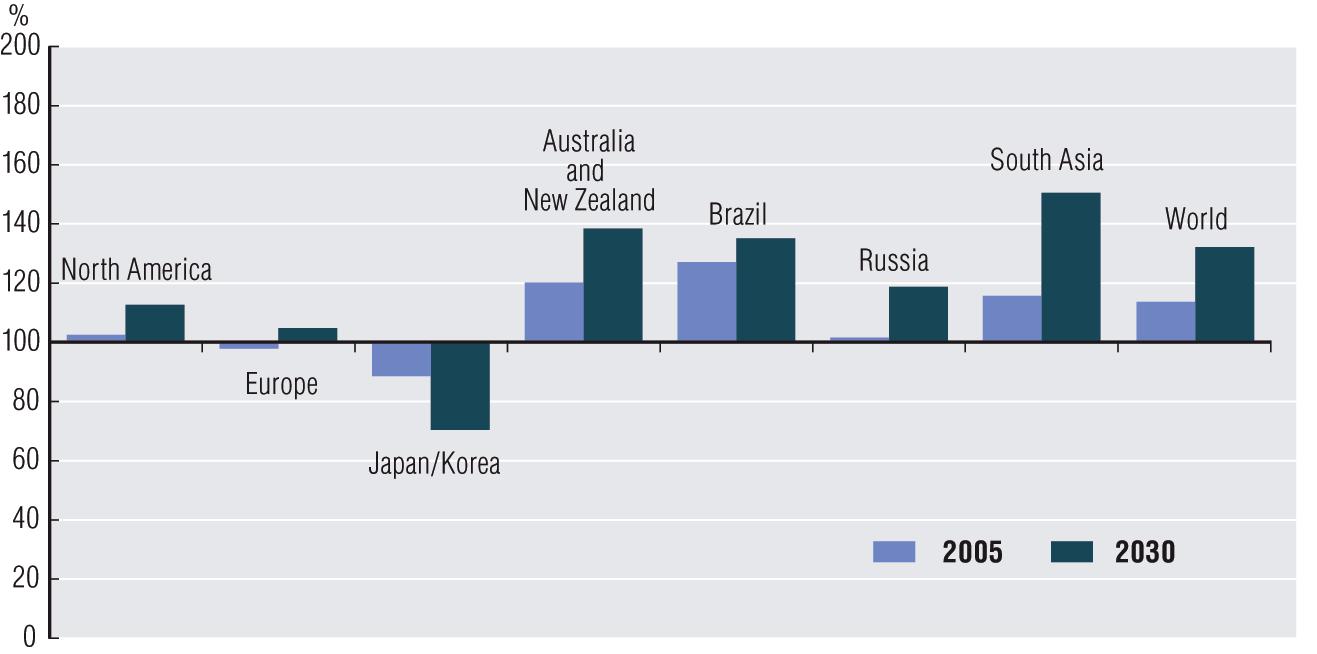
Source: OECD (2008), Environmental Outlook to 2030
12 http://dx.doi.org/10.1787/261200778155
Environmental Outlook to 2030 is available at www.oecdbookshop.org, ISBN 9789264040489.
Bright exports
Some 72% of people born in Jamaica and holding a tertiary education degree live in OECD countries, a new report finds. Though Jamaica is the country with by far the highest emigration rate among people with such third-level qualifications (earned at home or abroad), the new study shows several OECD countries also feature highly. The data, which cover the stock of emigrants up to 2000, indicate that 22.1% of Ireland’s academic elite live in other OECD countries compared with over 10% for the UK. In contrast, just over 3% of people born in Turkey and holding a tertiary qualification live in other OECD countries.
For the OECD generally, the emigration rate tends to be higher for people with tertiary qualifications than for the population as a whole, driven mostly by a lack of employment opportunities, social or political instability at home, or the prospect of higher pay and a better quality of life elsewhere. It raises several policy questions. There is the brain drain, as countries fail to retain their surgeons, teachers, engineers, etc. Also, highly skilled immigrants often find themselves in jobs for which they are overqualified. Policies to better integrate these groups would benefit the immigrants and their host countries, the report says. Women face particular difficulties, even in relatively egalitarian Nordic countries, where there is a 12% difference between employment rates of foreign-born and native-born women.
A Profile of Immigrant Populations in the 21st Century at www.oecdbookshop.org, ISBN 9789264040908.
Graduates abroad
Total emigration rate and tertiary-educated emigration rate, 2000
80
70
60
50
40
30
20 Total (%) Tertiary-educated (%)
10
0 GermanyDenmarkIrelandPortugalTurkey UK USJamaicaCongo
Note: More countries available in source Source: A Profile of Immigrant Populations in the 21st Century, OECD 2008
12 http://dx.doi.org/10.1787/248562215765
